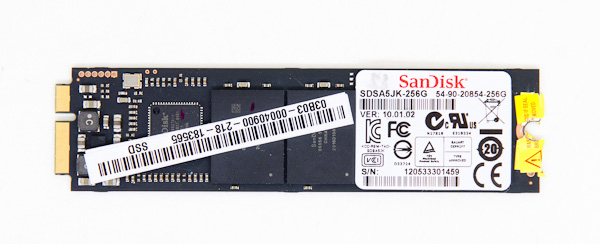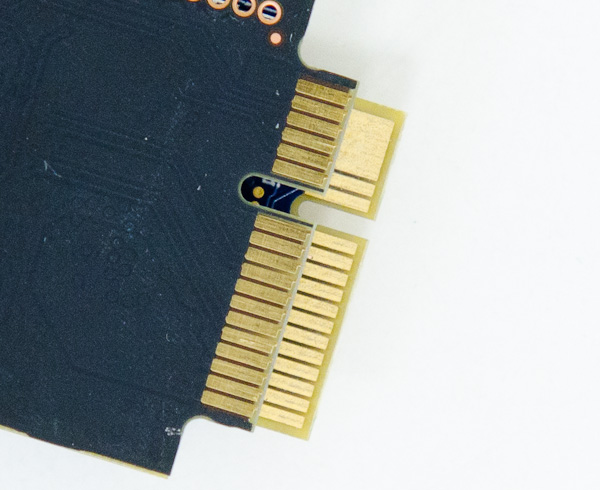ASUS' Zenbook SSD and Apple's MacBook Air SSD Are Not Compatible
by Anand Lal Shimpi on May 23, 2012 2:16 AM EST- Posted in
- Storage
- Mac
- Apple
- MacBook Air
- Laptops
- Zenbook
- Zenbook Prime
- Ultrabook
In working on yesterday's Zenbook Prime review I ran into a problem with the 256GB Sandisk U100 drive that came with my review sample. Unfortunately, since the drive doesn't use a common form factor or physical interface I was limited in my ability to diagnose the problem. Luckily I happen to have a handful of Zenbooks around the lab, one of which had a 128GB U100 that I could swap in, allowing me to complete yesterday's review. I'm going to carry the dying 256GB U100 with me to Taiwan in a little over a week to hand off to ASUS for some forensic analysis.

The Sandisk U100, a poor performer but the only option in the Zenbook Prime
While I was trying to diagnose the problem with the SSD I wondered if I could use the Zenbook's SSD in OWC's USB enclosure for MacBook Air SSDs. The OWC enclosure simply routes SATA power and data pins to the MacBook Air SSD connector. The MBA (and Zenbook) SSDs are obviously SATA compatible, they simply feature a different physical (and electrical) pinout compared to the SATA drives we're used to. Both SSDs feature a proprietary gumstick form factor and appear to have a similar connector. Since I couldn't find any info online about compatibility between the two, I decided to do a little investigating of my own.
The standard SATA spec calls for a 7-pin data interface and a 15-pin power interface for a total of 22 pins. The ASUS Zenbook/Zenbook Prime SSD features a split connector with 12 pins on the larger portion and 6 on the remaining - I assume for power and data, respectively. The MacBook Air SSD on the other hand has a 12 + 2 pin configuration, with a large power, ground or non-connected pin occupying the remainder of the smaller part of the connector. It's always possible, albeit unlikely, that both ASUS and Apple settled on the exact same pinout for their interfaces, thus making these two form factors electrically compatible but with slightly different configurations. However if you line up the two connectors you'll see that there are physical differences that preclude using one in lieu of the other:

Zenbook SSD (top) vs. MacBook Air SSD (bottom)
The Zenbook SSD's pins are slightly offset from those on the MBA's SSD. The ASUS connector is also slightly wider, which means that even if you can physically force it into a MBA you risk the pins not lining up properly and shorting something out (assuming the two interfaces are even remotely electrically compatible to begin with, which is a long shot at best). What about the reverse? The SSD in a MacBook Air has a narrower notch than its ASUS counterpart and won't physically install in a Zenbook/Zenbook Prime.
In other words, the MacBook Air and Zenbook SSDs are not compatible with one another. This is most unfortunate for ASUS as Apple already has companies making SSD replacements for the MacBook Air. I suspect that after the Zenbook Prime officially starts shipping we may start to see some interest from SSD makers. Anyone looking to get a head start on the competition should pick up a Zenbook now and begin work on a faster/better alternative to the U100 that's going to be shipping with all Primes.
One last thing, neither of these SSD form factors is compatible with mSATA although they look similar at a distance. mSATA features a wider, double-sided connector with more pins than either of these two options.
















22 Comments
View All Comments
Penti - Friday, May 25, 2012 - link
I thought mSATA was published as part of the SATA 3.1 specifications. As of SATA 3.1 it is a physical Mini PCI Express connector which is compatible with both mSATA and Mini PCI Express (PCIe) automatically now eliminating the need for a dedicated mSATA slot at all. I.e. mSATA as it is already implemented today. mSATA is also highly proliferated already and lots of boards and laptops supports it. It is already a reality. Plus there already is mSATA drives on the open market.That said it is actually not a cost issue at all to just order a custom PCB/connector design. Asus might actually save money that way, I have no idea where the commentator a bit above in the thread is coming from it's certainly not anything expensive to have a simpler design and custom order your own SATA PCBs. SSDs are really simple board designs and OWC can even design and build their own Apple compatible version by contract manufacturing in the US. Plenty of memory module/pcb assembly companies build SSDs. SATA data signaling is just four pins. Changing just the connector is a easy part, Sandisk designed the PCB / SSD itself here. Asus needed no logic to switch between PCIe and SATA on the board. Apple started using their design back in 2010, when the situation wasn't that clear and no-one had mSATA SSDs out on the open market. Asus probably just didn't want to bother implementing mSATA, but Dell, HP, Lenovo and the rest has already done that on their laptops. Maybe not at all their ultraportables yet though. There is also a JEDEC-standard for the physical mSATA cards which match the Mini PCI Express / Mini PCIe Card standard. As well as none standard longer versions around. Say a Samsung mSATA SSD does comply with the JEDEC standard and works in a mSATA slot which if it has the circuitry also supports PCIe and ordinary Mini PCI Express cards. As the SATA 3.1 specification it couldn't be clearer. You can fit a 256GB SSD here easily. Those behind the specification certainly jumped on it so it is already around and the official specification is nearly a year old already.
fmcjw - Monday, June 4, 2012 - link
for all I know there should be 2 kinds of mSATA cards, the fat kind that everyone uses, and the thin one by Apple. I don't know about Toshiba, but it's plain stupidity for any manufacturer to use a third kind.greylica - Wednesday, May 23, 2012 - link
Their stupid vendor lock in to sustain stupid patents will turn all of those non standard technology pieces into a problem for technicians in the future. What will happen ?In one point in the future, the Technicians will start to ask users to throw away the entire machine (even if it's usefull) because it will be expensive to find counterparts whereas new machines will be cheap to buy.
This is our patent war helping to construct more electronic trash piles...
ImSpartacus - Wednesday, May 23, 2012 - link
It's awesome that Anandtech pursues this kind of stuff, but I'm really waiting for the 13W battery life numbers!ajp_anton - Wednesday, May 23, 2012 - link
Is it possible to manually route the pins correctly? Assuming there's room inside to place the SSD away from the connector and some extra wires.phoenix_rizzen - Wednesday, May 23, 2012 - link
If you look at the placement of the normal SATA power and data connectors, they're only about 3 cm in total width. Is that really too wide? Really? Why not just go with a "bare" SATA connector (meaning just the pins, like in the photos) for power and data, and just slide it in? Why the need to come up with a new connector?phoenix_rizzen - Wednesday, May 23, 2012 - link
I mean, really, the Asus design saves a whole 3 pins. Wowee! That's going to save a tonne of money down the line. :rolleyes:And the Apple design saves a whole 8 pins, but has a huge ground or whatever, that takes up the same amount of space as 3-4 pins, so not really much savings there.
zcs1957 - Tuesday, November 6, 2012 - link
Hello, my ssd is damage, where can I find SDSA5JK?...thanks is advancepockets101 - Monday, March 18, 2013 - link
Has any one noticed that the this weird PCI-e type connector is the same as the UX31E WIFI / BT CARD as pictured on the link below? Even that's not a standard. There are adapters available in eBay for read/write access via a sandard 2.5 Sata so why can't this be reversed by a simple inverted connector?http://www.ebay.com/itm/Asus-UX31E-GENUINE-WIFI-BT...
pockets101 - Monday, March 18, 2013 - link
Is it at all possible that on the these SSD's could work?http://www.ebay.com/itm/Asus-EeePC-HDD-SSD-128GB-M...